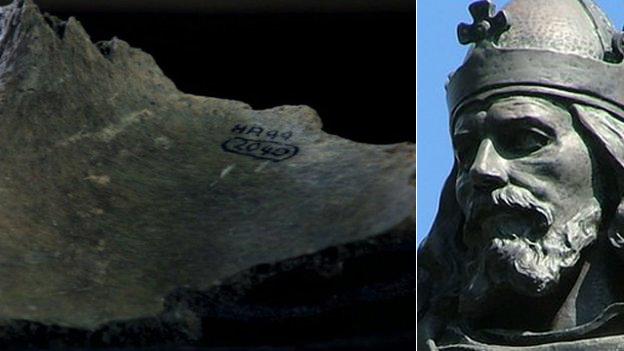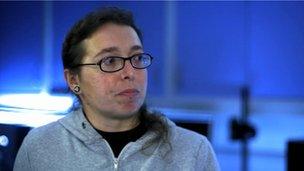Bone fragment 'could be King Alfred or son Edward'
- Published

The fragment of pelvis dates back to the period in history when King Alfred died
A fragment of pelvis bone unearthed in Winchester in 1999 may belong to King Alfred the Great or his son Edward the Elder, academics have said.
It was found at a previous dig at Hyde Abbey and has been dated to 895-1017 - the era the king died.
Experts were originally testing remains exhumed last year from an unmarked grave at St Bartholomew's Church, where it was thought he was buried.
But they were found to be from the 1300s, not 899, when the king died.
The fragment of pelvis had been among remains stored in two boxes at Winchester's City Museum and was tested by academics at Winchester University after their study into the exhumed remains proved fruitless.
The university and the community group behind the search, Hyde900, are now calling for further excavations at Hyde Abbey Gardens in the hunt for more remains.
'Hard to prove'
Experts said the bone, recovered from the site of the abbey, came from a man who was aged between 26 and 45-plus at the time of his death, leading them to believe it could be either Alfred or his son Edward.
Dr Katie Tucker, whose examination of the bones will feature in a BBC documentary, said: "These are the bones that were found closest to the site of the high altar.
"As far as we know, from the chronicles and the records, the only individuals close to the site of the high altar who are the right age when they died and the right date when they died would either be Alfred or Edward."
The remains at St Bartholomew's Church, which carbon dating showed to be from the wrong era, were exhumed last year amid security fears after publicity surrounding the discovery of Richard III's remains under a Leicester car park.
Dr Tucker said she was later made aware of the remains found at Hyde Abbey.
No analysis of that find was conducted due to a lack of funding and because a bone discovered next to it was found to be from the 17th or 18th century, and it was not thought to be of any interest.
Dr Tucker then arranged for tests to be carried out on the pelvic bone.
She said: "The simplest explanation, given there was no Anglo-Saxon cemetery at Hyde Abbey, is that this bone comes from one of the members of the West Saxon royal family brought to the site.
DNA match
"Given the age at death of the individual and the probable male identity, the plausible candidates are King Alfred, King Edward the Elder, or the brother of King Edward, Aethelweard."
Richard Buckley, co-director of the University of Leicester's archaeology services, led the search for Richard III.

Dr Katie Tucker believes the fragment belongs to a member of the West Saxon royal family
He said it would be "very hard to prove" the bone belongs to King Alfred.
"With Richard III we had to build a case with lots of different threads, we knew historic accounts... including trauma on the skeleton, we knew he died a violent death," he said.
"We got to the point with the balance of probability that it was him, with the DNA it meant we could say it was beyond reasonable doubt.
"The difficulty with this bone is that it is only one bone, you're having to rely on historical accounts of only two males being brought and reburied there - Alfred and his son - it depends if any males may have been buried without documentation.
"If they could find an articulated skeleton there could be other clues."
The King Alfred team said it may be possible to extract DNA from the pelvic bone but the problem would be finding another DNA source to check it with.
Dr Tucker said they tried to get a sample from Alfred's granddaughter, who is buried in Germany, but efforts failed as her grave was not well preserved.
The investigation is the subject of a BBC2 documentary due to be broadcast on Tuesday 21 January at 21:00 GMT.
- Published17 January 2014
- Published17 January 2014
- Published9 August 2013
- Published6 August 2013
- Published26 March 2013
- Published5 February 2013
- Published4 February 2013
- Published14 September 2012